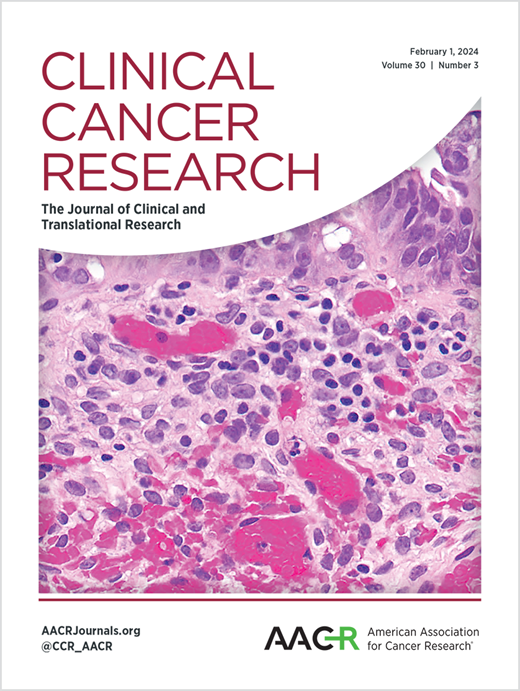Molecular characterization of residual muscle-invasive bladder cancer identifies a scar-like transcriptomicprofile with favorable prognosis after neoadjuvant therapy
IF 10
1区 医学
Q1 ONCOLOGY
引用次数: 0
Abstract
Introduction: Many patients have residual disease after neoadjuvant therapy but their prognosis and need for adjuvant therapy is unclear. This study evaluates patient prognosis based on the molecular profiling of residual disease at cystectomy. Methods: RNA-seq data from TURBT samples was available from N=84 ABACUS patients of whom N=64 had matched RC samples, including 10 patients with pathologic complete response (pCR, ypT0N0). Pre- and post-atezolizumab tumor gene expression data was classified into molecular subtypes using the consensus subtyping model as a benchmark. Unsupervised consensus clustering (CC) was performed to categorize RC samples de novo, and each cluster was characterized using gene expression signatures. Two RC cohorts (NAC, N=133 & UTSW, N=94) known to harbor a scar-like biologic cluster were used for training and testing of a single-sample transcriptomic classifier (TC) that was validated in two independent (PURE-01, N=26 & ABACUS, N=64) RC cohorts after neoadjuvant immunotherapy. Results: Unsupervised CC revealed four distinct post-atezolizumab clusters (scar-like, basal, luminal-stromal & luminal). The scar-like cluster was present in 25% (16/64) of the post-atezolizumab samples and expressed genes associated with wound healing/scarring. A transcriptomic classifier (TC) trained to identify a favorable scar-like transcriptomic profile in residual bladder tumors showed robust performance in two validation cohorts, indicating a patient subgroup with favorable prognosis among NAC-treated, pembrolizumab-treated and atezolizumab-treated residual bladder cancer patients. Conclusions: This study contributes to the framework for defining molecular subtypes at radical cystectomy. Residual bladder cancer with a scar-like transcriptomic profile may predict favorable patient prognosis after neoadjuvant chemo- and immunotherapy.残余肌肉浸润性膀胱癌的分子特征确定了新辅助治疗后预后良好的疤痕样转录组谱
许多患者在新辅助治疗后有残留病变,但其预后和是否需要辅助治疗尚不清楚。本研究基于膀胱切除术后残留疾病的分子谱来评估患者预后。方法:从N=84例ABACUS患者的turt样本中获取RNA-seq数据,其中N=64例与RC样本匹配,其中10例病理完全缓解(pCR, ypT0N0)。采用共识亚型模型作为基准,将atezolizumab治疗前和治疗后肿瘤基因表达数据划分为分子亚型。采用无监督共识聚类(CC)对RC样本进行从头分类,并使用基因表达特征对每个聚类进行表征。2个RC队列(NAC, N=133 &;已知含有疤痕样生物簇的UTSW, N=94)用于训练和测试单样本转录组分类器(TC),该分类器在两个独立的(PURE-01, N=26 &;ABACUS,新辅助免疫治疗后的64个RC队列。结果:无监督CC显示四种不同的atezolizumab后簇(疤痕样,基底,发光基质和;腔的)。25%(16/64)的atezolizumab后样本中存在疤痕样簇,表达与伤口愈合/瘢痕形成相关的基因。在两个验证队列中,经过训练的转录组分类器(TC)可识别残留膀胱肿瘤中有利的疤痕样转录组谱,这表明在nac治疗、派姆单抗治疗和阿特唑单抗治疗的残留膀胱癌患者中存在预后良好的患者亚组。结论:本研究有助于确定根治性膀胱切除术分子亚型的框架。伴有疤痕样转录组谱的残余膀胱癌可能预示患者在新辅助化疗和免疫治疗后的良好预后。
本文章由计算机程序翻译,如有差异,请以英文原文为准。
求助全文
约1分钟内获得全文
求助全文
来源期刊

Clinical Cancer Research
医学-肿瘤学
CiteScore
20.10
自引率
1.70%
发文量
1207
审稿时长
2.1 months
期刊介绍:
Clinical Cancer Research is a journal focusing on groundbreaking research in cancer, specifically in the areas where the laboratory and the clinic intersect. Our primary interest lies in clinical trials that investigate novel treatments, accompanied by research on pharmacology, molecular alterations, and biomarkers that can predict response or resistance to these treatments. Furthermore, we prioritize laboratory and animal studies that explore new drugs and targeted agents with the potential to advance to clinical trials. We also encourage research on targetable mechanisms of cancer development, progression, and metastasis.
 求助内容:
求助内容: 应助结果提醒方式:
应助结果提醒方式:


